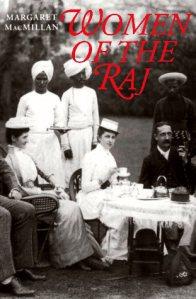
What’s it all about?:
In the nineteenth century, at the height of colonialism, the British ruled India under a government known as the Raj. British men and women left their homes and traveled to this mysterious, beautiful country–where they attempted to replicate their own society. In this fascinating portrait, Margaret MacMillan examines the hidden lives of the women who supported their husbands’ conquests–and in turn supported the Raj, often behind the scenes and out of the history books. Enduring heartbreaking separations from their families, these women had no choice but to adapt to their strange new home, where they were treated with incredible deference by the natives but found little that was familiar. The women of the Raj learned to cope with the harsh Indian climate and ward off endemic diseases; they were forced to make their own entertainment–through games, balls, and theatrics–and quickly learned to abide by the deeply ingrained Anglo-Indian love of hierarchy.
Weaving interviews, letters, and memoirs with a stunning selection of illustrations, MacMillan presents a vivid cultural and social history of the daughters, sisters, mothers, and wives of the men at the center of a daring imperialist experiment–and reveals India in all its richness and vitality.
What did I think?:
I read this book as part of a British Empire challenge that I’m participating in with my GoodReads group Bright Young Things, and I was fascinated to read about how British women lived and coped in India during the turbulent years of the nineteenth century. From the synopsis of this book however, I was expecting something a little different. As stated in the synopsis, the author does draw her research from a series of interviews and letters, and there are some stunning photographs and illustrations in the book from the files of her own grandmother, so that also adds the personal touch and makes the story all the more authentic. However, I was expecting the book to be entirely made up of interviews, letters etc, the evidence from the ladies who were there in their own words and what I got was more of a narrative with the occasional name and date thrown in for good measure. This wasn’t necessarily a bad thing, but it just wasn’t what I was led to believe from the synopsis.
Back to the book – the author divides it up into a number of sections which I found quite effective. Examples of which include Women in Danger, Courtship and Marriage, Children: Outposts of Empire, Housekeeping, Social Life and Amusements, and Unconventional Women which were among my favourites. What I did find fascinating (though unbelievable by todays standards) was how Britain could swan in, “lay claim” to India during the British Colonialism, and then have them serve their ladies and gentleman like they were beneath them. Sorry, just a slight issue and shame I have with my own country. Anyway, it was often seen as quite a great adventure for some ladies to come and live with their husbands in a foreign climate, (never mind what they often had to endure on the horrendous voyages over), once they arrived, things perhaps were not as exotic as they had pictured? Hotter than hot, with biting insects, the risk of disease, and we must remember the fashions of those times weren’t exactly conducive to a comfortable stay in tropical weather:
“In the nineteenth century they had insisted on crinolines and bustles. (As a result some credulous Indians believed that European women had tails.) Laugh out loud quote for me, and I couldn’t resist including it.
So now “uncomfortably” ensconced in India, the women now have to get used to the fact that they may not see their husbands that often due to work commitments, and they must get used to dealing with their household of Indian servants. Harder than it seems when you don’t know the language or the customs, and could be in danger of desperately offending someone. Social life could also be either considerably stale, with the same small communities, idle chatter and boredom or the opportunity for a bit of adultery if you were that way inclined, and as the author tells us Ethel Savi recalled “women were ready to make merry in the mountains while their husbands toiled on the plains.” There was even a regiment so renowned for their loose morals they were christened “The Fornicating Fifth.” Shocking!
There is a lot of sadness in this book however, namely when it came to bearing children which posed a hazard in itself with the reduced medical expertise available to women in labor. Minnie Blaine’s treatment for “inward piles” at the birth of her second son, ranged from leeches to hot fomentations on her stomach, from enemas of opium to “the Galvanic Battery.” I don’t even want to know! Battling through the traumas of birth, mothers then had the fight to keep their children alive. Many succumbed to common ailments such as colds, colic, dysentery, fever and sunstroke then you have the added danger of malaria and smallpox to contend with. Also, we must remember that diseases of this type and their treatment was little known about until the end of the nineteenth century so many children suffered and died early in their lives. And if they survived this, children were often sent back to England for their schooling at a certain age, so the woman had to decide whether to accompany her child and abandon her husband or vice versa.
This was definitely an intriguing and yes at points uncomfortable read for me, but I think it is important that we have books like this to show us our history and the history of other countries so we can hopefully learn from our mistakes. I think we can look on the Women of the Raj and laugh sometimes at their whims and fancies, and perhaps scold for their attitudes but they were undeniably brave to journey to a distant land with no idea what they were letting themselves in for.
Would I recommend it?:
But of course!
Star rating (out of 5)

:

